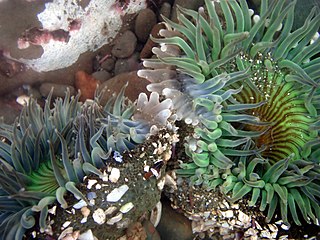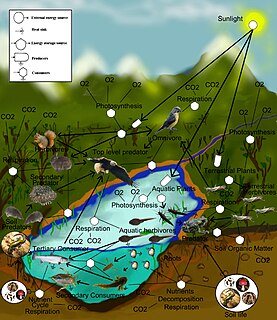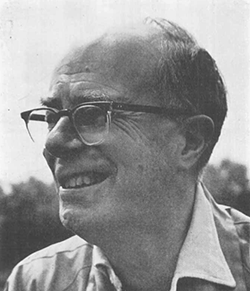The Lotka–Volterra equations, also known as the predator–prey equations, are a pair of first-order nonlinear differential equations, frequently used to describe the dynamics of biological systems in which two species interact, one as a predator and the other as prey. The populations change through time according to the pair of equations:

Alfred James Lotka was a US mathematician, physical chemist, and statistician, famous for his work in population dynamics and energetics. An American biophysicist, Lotka is best known for his proposal of the predator–prey model, developed simultaneously but independently of Vito Volterra. The Lotka–Volterra model is still the basis of many models used in the analysis of population dynamics in ecology.

Population ecology is a sub-field of ecology that deals with the dynamics of species populations and how these populations interact with the environment. It is the study of how the population sizes of species change over time and space. The term population ecology is often used interchangeably with population biology or population dynamics.

A metapopulation consists of a group of spatially separated populations of the same species which interact at some level. The term metapopulation was coined by Richard Levins in 1969 to describe a model of population dynamics of insect pests in agricultural fields, but the idea has been most broadly applied to species in naturally or artificially fragmented habitats. In Levins' own words, it consists of "a population of populations".

Character displacement is the phenomenon where differences among similar species whose distributions overlap geographically are accentuated in regions where the species co-occur, but are minimized or lost where the species’ distributions do not overlap. This pattern results from evolutionary change driven by biological competition among species for a limited resource. The rationale for character displacement stems from the competitive exclusion principle, also called Gause's Law, which contends that to coexist in a stable environment two competing species must differ in their respective ecological niche; without differentiation, one species will eliminate or exclude the other through competition.
The term niche differentiation, as it applies to the field of ecology, refers to the process by which competing species use the environment differently in a way that helps them to coexist. The competitive exclusion principle states that if two species with identical niches compete, then one will inevitably drive the other to extinction. When two species differentiate their niches, they tend to compete less strongly, and are thus more likely to coexist. Species can differentiate their niches in many ways, such as by consuming different foods, or using different parts of the environment.
The paradox of enrichment is a term from population ecology coined by Michael Rosenzweig in 1971. He described an effect in six predator–prey models where increasing the food available to the prey caused the predator's population to destabilize. A common example is that if the food supply of a prey such as a rabbit is overabundant, its population will grow unbounded and cause the predator population to grow unsustainably large. That may result in a crash in the population of the predators and possibly lead to local eradication or even species extinction.

Competition is an interaction between organisms or species in which both the organisms or species are harmed. Limited supply of at least one resource used by both can be a factor. Competition both within and between species is an important topic in ecology, especially community ecology. Competition is one of many interacting biotic and abiotic factors that affect community structure. Competition among members of the same species is known as intraspecific competition, while competition between individuals of different species is known as interspecific competition. Competition is not always straightforward, and can occur in both a direct and indirect fashion.

Interspecific competition, in ecology, is a form of competition in which individuals of different species compete for the same resources in an ecosystem. This can be contrasted with interspecific cooperation, a type of symbiosis. Competition between members of the same species is called intraspecific competition.
A population model is a type of mathematical model that is applied to the study of population dynamics.
In mathematical biology, the community matrix is the linearization of the Lotka–Volterra equation at an equilibrium point. The eigenvalues of the community matrix determine the stability of the equilibrium point.
Relative species abundance is a component of biodiversity and refers to how common or rare a species is relative to other species in a defined location or community. Relative abundance is the percent composition of an organism of a particular kind relative to the total number of organisms in the area. Relative species abundances tend to conform to specific patterns that are among the best-known and most-studied patterns in macroecology. Different populations in a community exist in relative proportions; this idea is known as relative abundance.
The generalized Lotka–Volterra equations are a set of equations which are more general than either the competitive or predator–prey examples of Lotka–Volterra types. They can be used to model direct competition and trophic relationships between an arbitrary number of species. Their dynamics can be analysed analytically to some extent. This makes them useful as a theoretical tool for modeling food webs. However, they lack features of other ecological models such as predator preference and nonlinear functional responses, and they cannot be used to model mutualism without allowing indefinite population growth.
A trophic function was first introduced in the differential equations of the Kolmogorov predator–prey model. It generalizes the linear case of predator–prey interaction firstly described by Volterra and Lotka in the Lotka–Volterra equation. A trophic function represents the consumption of prey assuming a given number of predators. The trophic function was widely applied in chemical kinetics, biophysics, mathematical physics and economics. In economics, "predator" and "prey" become various economic parameters such as prices and outputs of goods in various linked sectors such as processing and supply. These relationships, in turn, were found to behave similarly to the magnitudes in chemical kinetics, where the molecular analogues of predators and prey react chemically with each other.

Coexistence theory is a framework to understand how competitor traits can maintain species diversity and stave-off competitive exclusion even among similar species living in ecologically similar environments. Coexistence theory explains the stable coexistence of species as an interaction between two opposing forces: fitness differences between species, which should drive the best-adapted species to exclude others within a particular ecological niche, and stabilizing mechanisms, which maintains diversity via niche differentiation. For many species to be stabilized in a community, population growth must be negative density-dependent, i.e. all participating species have a tendency to increase in density as their populations decline. In such communities, any species that becomes rare will experience positive growth, pushing its population to recover and making local extinction unlikely. As the population of one species declines, individuals of that species tend to compete predominantly with individuals of other species. Thus, the tendency of a population to recover as it declines in density reflects reduced interspecific competition (between-species) relative to intraspecific competition (within-species), the signature of niche differentiation.
The R* rule is a hypothesis in community ecology that attempts to predict which species will become dominant as the result of competition for resources. It predicts that if multiple species are competing for a single limiting resource, then whichever species can survive at the lowest equilibrium resource level can outcompete all other species. If two species are competing for two resources, then coexistence is only possible if each species has a lower R* on one of the resources. For example, two phytoplankton species may be able to coexist if one is more limited by nitrogen, and the other is more limited by phosphorus.















